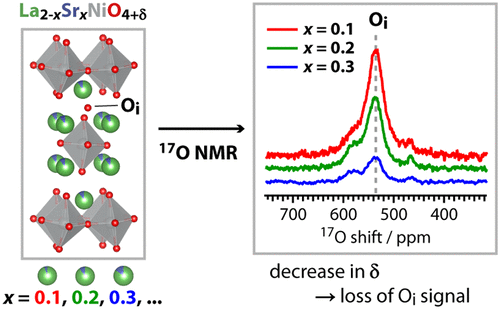当前位置:
X-MOL 学术
›
Chem. Mater.
›
论文详情
Our official English website, www.x-mol.net, welcomes your feedback! (Note: you will need to create a separate account there.)
Study of Defect Chemistry in the System La2–xSrxNiO4+δ by 17O Solid-State NMR Spectroscopy and Ni K-Edge XANES
Chemistry of Materials ( IF 8.6 ) Pub Date : 2018-06-18 00:00:00 , DOI: 10.1021/acs.chemmater.8b00747 David M. Halat 1 , Matthew T. Dunstan 1 , Michael W. Gaultois 1 , Sylvia Britto 1 , Clare P. Grey 1
Chemistry of Materials ( IF 8.6 ) Pub Date : 2018-06-18 00:00:00 , DOI: 10.1021/acs.chemmater.8b00747 David M. Halat 1 , Matthew T. Dunstan 1 , Michael W. Gaultois 1 , Sylvia Britto 1 , Clare P. Grey 1
Affiliation

|
The properties of mixed ionic–electronic conductors (MIECs) are most conveniently controlled through site-specific aliovalent substitution, yet few techniques can report directly on the local structure and defect chemistry underpinning changes in ionic and electronic conductivity. In this work, we perform high-resolution 17O (I = 5/2) solid-state NMR spectroscopy of La2–xSrxNiO4+δ, an MIEC and prospective solid oxide fuel cell (SOFC) cathode material, showing the sensitivity of 17O hyperfine (Fermi contact) shifts and quadrupolar coupling constants due to local structural changes arising from Sr substitution (x). Previously, we resolved resonances from three distinct oxygen sites (interstitial, axial, and equatorial) in the unsubstituted x = 0 material (Halat et al., J. Am. Chem. Soc.2016, 138, 11958). Here, substitution-induced changes in these three spectral features indirectly report on the ionic conductivity, local octahedral tilting, and electronic conductivity, respectively, of the (substituted) materials. In particular, the intensity of the 17O resonance arising from mobile interstitial defects decreases, and then disappears, at x = 0.5, consistent with reports of lower bulk ionic conductivity in Sr-substituted phases. Second, local distortions among the split axial oxygen sites diminish, even on modest incorporation of Sr (x < 0.1), which is also accompanied by faster spin–lattice (T1) relaxation of the interstitial 17O resonances, indicating increased mobility of the associated sites. Finally, the hyperfine shift of the equatorial oxygen resonance decreases due to conversion of Ni2+ (d8) to Ni3+ (d7) by charge compensation, a mechanism associated with improved electronic conductivity in the Sr-substituted phases. Valence and coordination changes of the Ni cations are further supported by Ni K-edge X-ray absorption near-edge structure (XANES) measurements, which show a decrease in the Jahn–Teller distortion of the Ni3+ sites and a Ni coordination change consistent with the formation of oxygen vacancies. Ultimately, these insights into local atomic and electronic structure that rely on 17O solid-state NMR spectroscopy should prove relevant for a broad range of aliovalently substituted functional paramagnetic oxides.
中文翻译:

通过17 O固态NMR光谱和Ni K-Edge XANES研究La 2– x Sr x NiO 4 +δ体系中的缺陷化学
通过特定位置的异价取代可以最方便地控制混合离子电子导体(MIEC)的特性,但很少有技术可以直接报告局部结构和缺陷化学,这些离子和电导率是离子和电子电导率变化的基础。在这项工作中,我们对La 2– x Sr x NiO 4 +δ(一种MIEC和预期的固体氧化物燃料电池(SOFC)阴极材料)进行了高分辨率的17 O(I = 5/2)固态NMR光谱分析,显示了由于Sr取代引起的局部结构变化而引起的17 O超精细(Fermi接触)位移和四极耦合常数的敏感性(x)。以前,我们解决了共振从在未取代的三种不同的氧位(间质,轴向和赤道)X = 0的物质(哈拉特等人,J。化学会会志。2016,138,11958)。在此,这三个光谱特征中由取代引起的变化分别间接报告了(取代)材料的离子电导率,局部八面体倾斜和电子电导率。特别是,由移动间隙缺陷引起的17 O共振强度在x处减小,然后消失。= 0.5,与在Sr取代相中较低的整体离子电导率的报道一致。其次,即使在适度掺入Sr(x <0.1)的情况下,分裂的轴向氧位点之间的局部变形也减小了,这还伴随着间隙17 O共振的更快的自旋晶格(T 1)弛豫,表明了Sr的迁移率增加相关网站。最后,由于Ni 2+(d 8)向Ni 3+(d 7)的转化,赤道氧共振的超精细位移减小。)是通过电荷补偿实现的,这种机制与Sr取代相中电子电导率的提高有关。Ni K边缘X射线吸收近边缘结构(XANES)测量进一步支持了Ni阳离子的价数和配位变化,这表明Ni 3+位点的Jahn-Teller畸变减少,并且Ni配位变化与氧空位的形成相一致。最终,这些依赖于17 O固态NMR光谱对局部原子和电子结构的见解应证明与广泛的异端取代的功能顺磁性氧化物有关。
更新日期:2018-06-18
中文翻译:

通过17 O固态NMR光谱和Ni K-Edge XANES研究La 2– x Sr x NiO 4 +δ体系中的缺陷化学
通过特定位置的异价取代可以最方便地控制混合离子电子导体(MIEC)的特性,但很少有技术可以直接报告局部结构和缺陷化学,这些离子和电导率是离子和电子电导率变化的基础。在这项工作中,我们对La 2– x Sr x NiO 4 +δ(一种MIEC和预期的固体氧化物燃料电池(SOFC)阴极材料)进行了高分辨率的17 O(I = 5/2)固态NMR光谱分析,显示了由于Sr取代引起的局部结构变化而引起的17 O超精细(Fermi接触)位移和四极耦合常数的敏感性(x)。以前,我们解决了共振从在未取代的三种不同的氧位(间质,轴向和赤道)X = 0的物质(哈拉特等人,J。化学会会志。2016,138,11958)。在此,这三个光谱特征中由取代引起的变化分别间接报告了(取代)材料的离子电导率,局部八面体倾斜和电子电导率。特别是,由移动间隙缺陷引起的17 O共振强度在x处减小,然后消失。= 0.5,与在Sr取代相中较低的整体离子电导率的报道一致。其次,即使在适度掺入Sr(x <0.1)的情况下,分裂的轴向氧位点之间的局部变形也减小了,这还伴随着间隙17 O共振的更快的自旋晶格(T 1)弛豫,表明了Sr的迁移率增加相关网站。最后,由于Ni 2+(d 8)向Ni 3+(d 7)的转化,赤道氧共振的超精细位移减小。)是通过电荷补偿实现的,这种机制与Sr取代相中电子电导率的提高有关。Ni K边缘X射线吸收近边缘结构(XANES)测量进一步支持了Ni阳离子的价数和配位变化,这表明Ni 3+位点的Jahn-Teller畸变减少,并且Ni配位变化与氧空位的形成相一致。最终,这些依赖于17 O固态NMR光谱对局部原子和电子结构的见解应证明与广泛的异端取代的功能顺磁性氧化物有关。



























 京公网安备 11010802027423号
京公网安备 11010802027423号